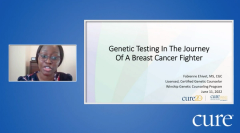
Educated Patient® Metastatic Breast Cancer Summit Genetic Testing Presentation: June 11, 2022
Watch Fabienne Ehivet, from Emory Saint Joseph’s Hospital, discuss genetic testing, during the CURE Educated Patient Metastatic Breast Cancer Summit.
Episodes in this series

When working correctly, tumor suppressor genes may prevent cancer cells from developing in the body. However, an abnormal change in those genes may lead to the growth of cancerous cells.
Recently, Fabienne Ehivet, a licensed and certified genetic counselor at Emory Saint Joseph’s Hospital of Atlanta, spoke about the significance of genetic testing in patients with breast cancer.
Ehivet was a panelist during CURE®’s Educated Patient® Metastatic Breast Cancer Summit.
She provided insight into how cancer starts, what genetic testing is, how the results of such tests may influence treatment decisions and much more.
What is Genetic Testing?
Ehivet explained that genetic testing is used to look for changes or abnormalities in a person’s DNA. She noted that DNA acts as a set of instructions for the body to grow and develop. Think of it, she said, as if the process was that DNA is a book of recipes, and genes are the recipes within the book.
All cancers start in a gene, according to Ehivet. As a result, she noted, all cancers are genetic in nature.
The genetic changes are either acquired throughout a person’s lifetime — via exposures to harmful chemicals, for example — or are present at birth.
To test for any abnormalities or changes, providers utilize two forms of genetic testing. The first, Ehivet mentioned, is genomic testing. In this case, the DNA of specific cancer cells are analyzed. The other form of genetic testing is known as germline testing. Here, providers are looking to analyze the DNA an individual was born with.
“Genomic testing or tumor testing, focus on the tumor itself,” she said. “And it looks for genetic changes, and how the changes in a gene make the cell behave.”
The important thing to note about genomic testing is that regardless of the findings, any mutation cannot be passed onto children. The reason, she said, is that whatever mutation is present is only found in the tumor and not in the individual’s DNA.
Why is Tumor Testing Considered?
Genomic testing may predict how fast a tumor will grow, Ehivet noted. This process may help patients and providers to jointly decide on what treatment is best for the particular cancer.
Moreover, genomic testing may shed enough light on a patient’s tumor where toxic effects of chemotherapy can be avoided.
“Now we know if a tumor is going to be aggressive or spread, so there's specific treatment to use,” she said.
Germline Testing 101
Germline testing is considered to be extremely valuable because it may identify abnormal changes to genes linked to hereditary syndromes, which may be passed down to children.
Moreover, other family members who may not expect cancer can find out if they have that genetic abnormality.
“And (then) they will have (the) option to start screening early, or consider surgery to prevent cancer,” explained Ehivet.
Germline testing also informs patients about other cancer risks they may have.
“I know we're talking about breast cancer patients, but someone with breast cancer who also (has a) genetic abnormality can also have increased risk for other cancers.”
For instance, if a there is an abnormality in the BRCA gene — such as BRCA1 or BRCA2 — there is the chance for an increased risk for ovarian cancer, pancreatic cancer and prostate cancer.
Just like genomic testing, germline testing may also be used to influence treatment decisions. If a patient has a BRCA mutation, Ehivet said that they are at a greater risk for developing contralateral breast cancer (a tumor that develops in the opposite breast of the primary location).
“Knowing that information they may decide to have, instead of a lumpectomy, a bilateral mastectomy,” she said.
Or a patient with breast cancer may consider having their ovaries removed following treatment if they have a germline mutation that increases their risk for ovarian cancer.
When to Consider Genetic Testing?
Different factors come into play when someone should consider genetic testing, according to Ehivet.
One of the most important factors to consider, she said, is the age at which the cancer is diagnosed.
“The younger the age of diagnosis, the most suspicious we have of cancer being hereditary,” she said.
Additionally, a person with multiple primary tumors, bilateral cancer, metastatic disease or triple-negative breast cancer should consider testing.
How is Genetic Testing Done?
Ehivet noted that a patient’s doctor will typically refer them to receive genetic counseling. During that session, a counselor will review the patient’s personal and family history to determine if genetic testing is appropriate.
To perform these tests, providers collect samples via the blood, saliva or the inside of a person’s cheek (which is known as a buccal swab or buccal smear).
Typically, the test results may take several weeks to be returned. However, she stressed, a rush order can be performed if a patient is waiting to use the results to decide on a treatment option.
Does Insurance Cover Genetic Testing?
Ehivet mentioned that many people are often concerned if insurance will cover genetic testing. As long as a patient meets the criteria for genetic testing, the insurance company will cover the costs, she said.
However, it is important to note if the insurance company has its own criteria for genetic testing. In the off-chance that the patient doesn’t have insurance coverage, Ehivet said they can elect to pay for the testing out-of-pocket. Although it’s not a definitive cost, patients can expect to pay upward of $250, according to Ehivet.
Another important factor Ehivet highlighted is that employers or health insurance companies cannot discriminate against a patient if they test positive for a genetic mutation. However, the law which offers that protection — known as the GINA Act — does not apply to life insurance, long-term care or disability insurance.
For more news on cancer updates, research and education, don’t forget to















